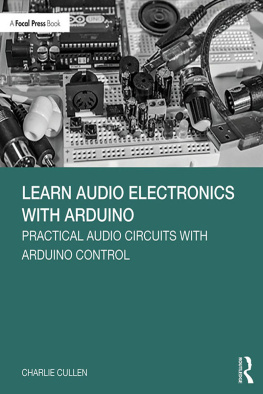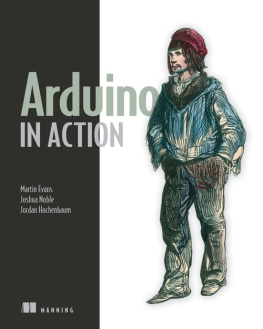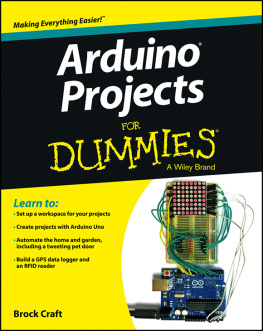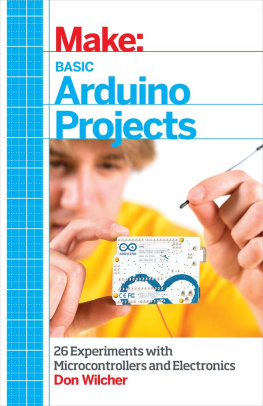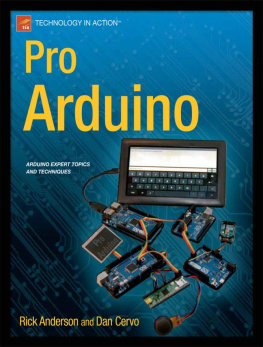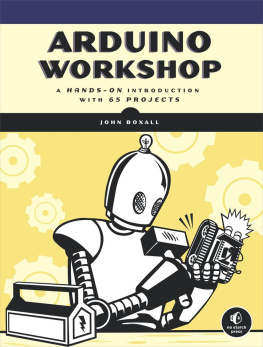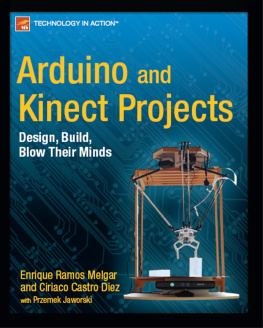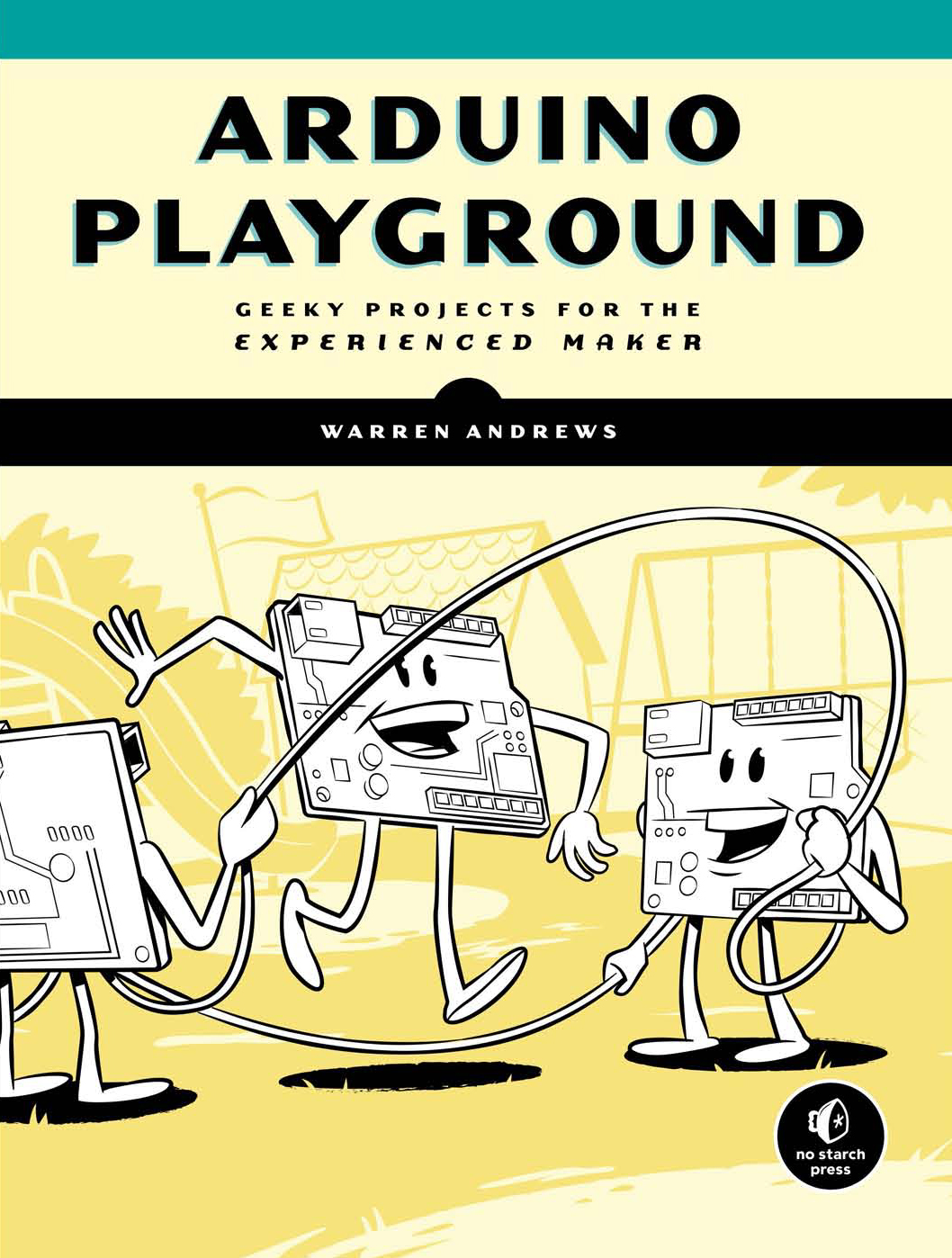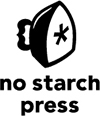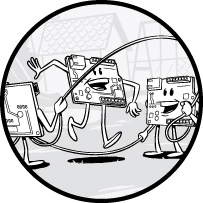Contents in Detail
ARDUINO PLAYGROUND
Geeky Projects for the Experienced Maker
Warren Andrews
San Francisco
ARDUINO PLAYGROUND. Copyright 2017 by Warren Andrews.
All rights reserved. No part of this work may be reproduced or transmitted in any form or by any means, electronic or mechanical, including photocopying, recording, or by any information storage or retrieval system, without the prior written permission of the copyright owner and the publisher.
21 20 19 18 17 1 2 3 4 5 6 7 8 9
ISBN-10: 1-59327-744-X
ISBN-13: 978-1-59327-744-4
Publisher: William Pollock
Production Editor: Laurel Chun
Cover Illustration: Josh Ellingson
Interior Design: Octopod Studios
Developmental Editor: Jennifer Griffith-Delgado
Technical Reviewer: Scott Collier
Copyeditor: Julianne Jigour
Compositor: Laurel Chun
Proofreader: James Fraleigh
Indexer: BIM Creatives, LLC
For information on distribution, translations, or bulk sales, please contact No Starch Press, Inc. directly:
No Starch Press, Inc.
245 8th Street, San Francisco, CA 94103
phone: 1.415.863.9900;
www.nostarch.com
Library of Congress Cataloging-in-Publication Data
Names: Andrews, Warren, author.
Title: Arduino playground : geeky projects for the experienced maker / by
Warren Andrews.
Description: San Francisco : No Starch Press, [2017] | Includes index.
Identifiers: LCCN 2016013631 (print) | LCCN 2016019891 (ebook) | ISBN
9781593277444 (pbk.) | ISBN 159327744X (pbk.) | ISBN 9781593277857 (epub)
| ISBN 9781593277864 (mobi) | ISBN 1593277865 (mobi)
Subjects: LCSH: Arduino (Programmable controller) | Electric
circuits--Computer-aided design.
Classification: LCC TJ223.P76 A54 2017 (print) | LCC TJ223.P76 (ebook) | DDC
621.381--dc23
LC record available at https://lccn.loc.gov/2016013631
No Starch Press and the No Starch Press logo are registered trademarks of No Starch Press, Inc. Other product and company names mentioned herein may be the trademarks of their respective owners. Rather than use a trademark symbol with every occurrence of a trademarked name, we are using the names only in an editorial fashion and to the benefit of the trademark owner, with no intention of infringement of the trademark.
The information in this book is distributed on an As Is basis, without warranty. While every precaution has been taken in the preparation of this work, neither the author nor No Starch Press, Inc. shall have any liability to any person or entity with respect to any loss or damage caused or alleged to be caused directly or indirectly by the information contained in it.
To all the electronic hobbyists and amateur radio operators who, throughout the years, have taken their hobbies to new levels
About the Author
Warren Andrews received his first amateur radio license at age 12 and has been an inveterate electronics hobbyist ever since. He has been writing about electronics for more than 30 years, and his work has been featured in publications like EE Times, Electronic Design, and Computer Design. He managed several publications in the RTC group and contributed extensively to all of their publications. Warren has also done extensive design and engineering development on a variety of commercial projects and was a technical consultant for several major corporations, including Motorola and GE. He holds one US Patent.
About the Technical Reviewer
Scott Collier is a self-taught Arduino Enthusiast who has created and published over 50 free Arduino tutorials on his blog: http://arduinobasics.blogspot.com. With more than 3.5 million views, it is very likely you have come across some of his work. Scott is an active online member of the Arduino community and fully supports the maker movement ideology.
CONTENTS IN DETAIL
0
SETTING UP AND USEFUL SKILLS
1
THE REACTION-TIME MACHINE
2
AN AUTOMATED AGITATOR FOR PCB ETCHING
3
THE REGULATED POWER SUPPLY
4
A WATCH WINDER
5
THE GARAGE SENTRY PARKING ASSISTANT
6
THE BATTERY SAVER
7
A CUSTOM PH METER
8
TWO BALLISTIC CHRONOGRAPHS
9
THE SQUARE-WAVE GENERATOR
10
THE CHROMATIC THERMOMETER
ACKNOWLEDGMENTS
I would like to acknowledge all the friends, colleagues, and fellow editors that offered help and encouragement during the production of my book. In particular, Id like to thank my friend Pete Yeatman, who consistently offered technical advice and counsel as I put together the various projects. In addition, Id like to thank the editors and production staff at No Starch Press for doing such an excellent job bringing the book to publication. And of course, what acknowledgment would be complete without thanking my wife and family who have put up with me during the difficult as well as the easy times.
INTRODUCTION
Welcome to Arduino Playground! This book provides a broad spectrum of projects demonstrating the flexibility and versatility of the Arduino family of microcontroller boards. Each project contains everything you need to know to build it, including a schematic, a component list, and any sketches (thats what Arduino folks call programs). I also endeavored to provide all information about the mechanical parts of each project, including a list of supplies, so you can complete any enclosures, moving parts, skeletons, and so on. Any special tools required are also described in the projects.
I have tried to make the projects more than just recipes for assembling the parts by including some background explanations of how I came up with the projects and how the technology works. I hope that the projects can be useful end products by themselves and, with some ingenuity, perhaps even serve as a launching pad for you to create projects of your own.
Who This Book Is For
Building the projects in this book does not require an engineering degree, advanced mechanical aptitude, or programming expertise. That said, there are some basic requirements you should have to get the most out of the book:
An understanding of basic electronics, including the ability to read a schematic diagram and recognize elements such as resistors and capacitors
An understanding of how to use computers and write software (Von Neumann architecture if you want to be snobby); knowledge of Arduino or other microcontroller architectures helps
Experience soldering connections and wires
Limited mechanical skills, such as how to operate an electric drill, various saws, and so on
My hope is that both beginner and experienced Arduino users will learn something new about electronics in these projects.
How This Book Is Organized
Each chapter focuses on one project and describes how to prototype it on a breadboard for testing, briefly discusses how the sketch works, and finally shows how to construct the final product.




